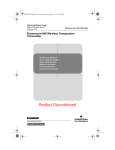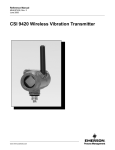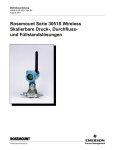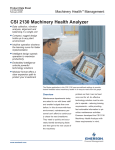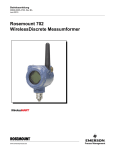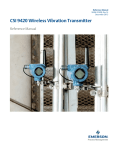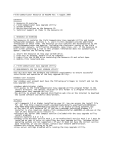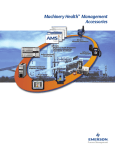Download AB International 9420A Installation guide
Transcript
Quick Installation Guide P/N MHM-97409.4 April 2010 CSI 9420 CSI 9420 Wireless Vibration Transmitter Start Step 1: Physical Installation Step 2: Verify Operation Step 3: Communication and Configuration End www.mhm.assetweb.com Quick Installation Guide P/N MHM-97409.4 April 2010 CSI 9420 © 2010 CSI. All rights reserved. All marks property of owner. Emerson Process Management European Headquarters Machinery Health Management Interleuvenlaan 50 Emerson Process Management Asia Pacific Private Limited 835 Innovation Dr. Knoxville, TN 37932 T (US) (800) 675-4726 F (865) 218-1401 3904 Room Central Plaza 18 Harbour Road Wan-Chai Hong Kong T 852-2802-9223 F 852-2802-8227 Reasearch Park Inerleuven B 3001 Leuven - Belgium T 32-16-741-403 F 32-16-400-457 IMPORTANT NOTICE This installation guide provides basic guidelines for the CSI 9420. It does not provide instructions for detailed configuration, diagnostics, maintenance, service, troubleshooting, or installations. Refer to the CSI 9420 reference manual (document number P/N 97408) for more instruction. The manual and this QIG are also available electronically on www.mhm.assetweb.com. WARNING Explosions could result in death or serious injury: Installation of this transmitter in an explosive environment must be in accordance with the appropriate local, national, and international standards, codes, and practices. Please review the Product Certifications section for any restrictions associated with a safe installation. • Before connecting a 375 Field Communicator in an explosive atmosphere, ensure the instruments are installed in accordance with intrinsically safe or non-incendive field wiring practices. Electrical shock can result in death or serious injury • Avoid contact with the leads and terminals. High voltage that may be present on leads can cause electrical shock. IMPORTANT NOTICE The CSI 9420 and all other wireless devices should be installed only after the 1420 Wireless Gateway has been installed and is functioning properly. Wireless devices should also be powered up in order of proximity from the 1420 Wireless Gateway, beginning with the closest. This will result in a simpler and faster network installation. IMPORTANT NOTICE Shipping considerations for wireless products (Lithium Batteries): Battery powered units are shipped without the power module installed. Please remove the power module pack prior to shipping the unit. Primary lithium batteries are regulated in transportation by the U.S. Department of Transportation, and are also covered by IATA (International Air Transport Association), ICAO (International Civil Aviation Organization), and ARD (European Ground Transportation of Dangerous Goods). It is the responsibility of the shipper to ensure compliance with these or any other local requirements. Please consult current regulations and requirements before shipping. 2 Quick Installation Guide P/N MHM-97409.4 April 2010 CSI 9420 This Quick Installation Guide applies to both the 2.4 GHz and 900 MHz Wireless HART versions of the CSI 9420. If you are unsure which version the device is, look in the upper right-hand corner of the nameplate, as illustrated in Figure 1 below. Figure 1. Nameplates with radio frequency version highlighted by circles 3 Quick Installation Guide CSI 9420 P/N MHM-97409.4 April 2010 STEP 1: PHYSICAL INSTALLATION The CSI 9420 and all other wireless devices should be installed only after the 1420 Wireless Gateway has been installed and is functioning properly. Powering the CSI 9420 Remove the rear cover of the device to access the power connections. For the battery powered version, simply plug in the power module. For the externally powered version, connect a 10...28V DC (24V nominal) power supply to the bottom two screw terminals on the right (see Figure 3). Pull the wiring through the threaded conduit entry. When selecting the power supply, note that each CSI 9420 has a peak current draw of 40 mA when awake and powering sensors. NOTE: Wireless devices should be powered up in order of proximity to the 1420 Wireless Gateway, beginning with the closest device to the 1420. This will result in a simpler and faster network installation. GENERAL SENSOR HANDLING INSTRUCTIONS The CSI 9420 utilizes special low-power sensors available from Emerson. Each sensor requires a standard 1/4” - 28 mounting location. Refer to the User’s Manual for detailed sensor mounting instructions. Sensor mounting instructions and practices are also available in a separate Sensor Installation Guide on the CD packaged with this device and at www.mhm.assetweb.com. To maintain mechanical isolation of the sensor, a Remote Mount configuration is required, as illustrated in Figure 2. In this configuration, the sensor is mounted separately from the CSI 9420 housing, then connected to the CSI 9420. Although not required for all installations, it is common to run the cable from the sensor to the housing through conduit. NOTE: The word “sensor” applies to both an accelerometer and an accelerometer with embedded temperature. The word “accelerometer” refers to a sensor that measures only acceleration. Remote Mount 1. Install sensor or accelerometers according to standard sensor installation practices. Be sure to use thread sealant on all connections. 2. Run wiring (and conduit if necessary) from the sensor to the CSI 9420. 3. Pull the wiring through the threaded conduit entry of the CSI 9420. If not using conduit, an appropriate grommet or cable-gland should be used to provide both strain relief for the cable and environmental isolation for the CSI 9420. 4. Attach the sensor wiring to the terminals as indicated in tables 1-3. 5. Connect the power pack module or external 24V DC power supply. 6. Close the housing cover and tighten to safety specification. Always ensure a proper seal by installing the electronics housing covers so that metal touches metal, but do not over 4 Quick Installation Guide P/N MHM-97409.4 April 2010 CSI 9420 tighten. 7. Position the antenna such that it is vertical, either straight up or straight down. Figure 2. Remote mounting of the CSI 9420 involves mounting the device away from the equipment to be measured (upper left), connecting a sensor or accelerometers to the equipment and the CSI 9420 (upper right), and removing the rear cover and power module of the device to connect the sensor wires (bottom). 5 Quick Installation Guide CSI 9420 P/N MHM-97409.4 April 2010 Connecting Sensors One or two accelerometers can be connected to the CSI 9420. Only one accelerometer with an embedded temperature sensor can be connected to the CSI 9420. Refer to Figure 3 showing the connector labels mentioned below. Figure 3. CSI 9420 Terminal Diagram (battery powered version and externally powered version) Table 1. Connecting One Accelerometer to the CSI 9420 Connecting One Accelerometer Connector labeled 1: Connector labeled 2: Connector labeled 3: Connector labeled 4: Sensor Power Sensor Signal Unused Sensor Common (Red Wire) (White Wire) (Black Wire) Table 2. Connecting Two Accelerometers to the CSI 9420 Connecting Two Accelerometers Connector labeled 1: Connector labeled 2: Connector labeled 3: Connector labeled 4: Power - Both Sensors Signal - Sensor 1 Signal - Sensor 2 Sensor Commons (Two Red Wires) (White Wire) (White Wire) (Two Black Wires) Table 3. Connecting One Sensor with Vibration and Temperature Connecting One Sensor with Vibration and Temperature Connector labeled 1: Connector labeled 2: Connector labeled 3: Connector labeled 4: Sensore Power Vibration Signal Temperature Signal Sensor Common (Red Wire) (White Wire) (Green Wire) (Black wire) 6 Quick Installation Guide P/N MHM-97409.4 April 2010 CSI 9420 STEP 2: VERIFY OPERATION Operation can be verified by four methods: Viewing the LCD screen on the device, using the 375/475 Field Communicator, using the 1420 Wireless Gateway’s integrated web server, or using AMS™ Suite: Intelligent Device Manager (or other compatible HART-enabled host). Refer to Step 3: Communications and Configuration for details regarding each method. If the LCD is installed and enabled, during normal operation, the LCD displays the measured values at the configured update rate. Every time the CSI 9420 device wakes up to make a measurement it displays these screens and then takes the measurement. Refer to the CSI 9420 User’s Manual for error codes and other LCD messages. Press the Diagnostic (DIAG) button once and the CSI 9420 will cycle through display of the TAG, Device ID, Network ID, Network Join Status and Device Status screens, then make a measurement. Pressing the DIAG button causes this information to be displayed even if the LCD is disabled for normal operation. NOTE: To access the DIAG button, remove the front cover of the CSI 9420. The Network join status as displayed on the LCD is shown in Figures 4 for the 2.4 GHz and Figure 5 for the 900 MHz versions. Prior to configuring the device to join a network, it will remain in the Network Search mode. CSI 9420 2.4 GHz, Wireless HART Figure 4. Network join status (2.4 GHz) Searching for Network Joining Network Connected Operational and ready to send data CSI 9420 900 MHz Figure 5. Network join status (900 MHz) 7 Searching for Network Joining Network Connected with 1 Parent Connected with 2 Parents netwk netwk netwk netwk a -srch joing 1parnt 2parnt Quick Installation Guide CSI 9420 P/N MHM-97409.4 April 2010 STEP 3: COMMUNICATION AND CONFIGURATION 375/475 Field Communicator In order to communicate with a 375 or 475 Field Communicator, the CSI 9420 device must be powered by connecting the power module pack, or connecting external 24V DC power. Also, the initial boot and acquisition cycle must be complete (This is indicated when the LCD screen goes blank after a number of messages are displayed). If no LCD is installed, or if the LCD is disabled, wait about 30 seconds after powering the device before attempting to communicate on the wired interface. To use the 375/475 Field Communicator with the rev 3 CSI 9420, a rev 3 DD (Device Description file) is required. The rev 3 DD for the CSI 9420 is located on the CD that is shipped with the CSI 9420. 375/475 System Software version 3.2 or later is also required. Refer to Figure 6 for an illustration of connecting the 375/475 to the CSI 9420. The wired HART connection is located on the terminal block in the rear chamber of the device. It is a two-wire, polarity-independent connection. In the battery powered version, it is the bottom two terminals, labeled “COMM”. In the externally powered version, it is the top two screws on the right. NOTE Refer to the 375/475 Users’ Manual for details on DD’s or go to www.fieldcommunicator.com/syssoftdds.htm for instructions on adding a DD for the CSI 9420 or other new devices. Figure 6. 375 Field Communicator Connections (battery powered version) 8 Quick Installation Guide P/N MHM-97409.4 April 2010 CSI 9420 375/475 Field Communicator Connections (externally powered version) Once the wired connection is established, the device can be configured to communicate on the wireless network. The key sequences for the 2.4 GHz Wireless HART version and the 900 MHz version are shown in Table 4 and Table 5 respectively. Table 4. 2.4 GHz Function Key Sequence Menu Items Wireless 2, 2, 2 (Manual Setup) Wireless 2, 1, 2 (Guided Setup) Network Identifier, Join Device to Network, Broadcast Rates, Power Source, Power Save Publish Join Device to Network, Configure Publishing, Publish Rate Table 5. 900 MHz Function Key Sequence Menu Items Network 1, 1, 7 Network ID, Set Network ID / Join Key Device-specific configuration may optionally be done at this point, if needed. This includes specifying the type of sensor(s) installed, the process variables that are published, the publish rate, and the alert thresholds. Key sequences for common configuration tasks are shown in Table 6 for the 2.4 GHz Wireless HART version and Table 7 for the 900 MHz version. Table 6. CSI 9420 2.4 GHz Fast Key Sequence Function Key Sequence Initial Setup 2, 1, 1 (Guided Setup) Device Setup Alert Setup 2, 2, 1 (Manual Setup) 2, 3 9 Menu Items Configure Sensors, Change Variable Mapping, Change Units, Alert Limits Units, Sensors, Variable Mappings Dependent on sensor configuration Quick Installation Guide P/N MHM-97409.4 April 2010 CSI 9420 Table 7. CSI 9420 900 MHz Fast Key Sequence Function Key Sequence Device Information 1, 1, 8 Sensor Config Network Variable Mapping Alarm Levels 1, 1, 3 1, 1, 7 1, 1, 2 1, 1, 6 Menu Items Tag, Date, Descriptor, Message, Distributor, Write Protect, Model, Dev ID, Final assbly num, Revision #’s Sensor 1, Sensor 2, Calibration Network ID, Set Network ID / Join Key PV is, SV is, TV is, QV is Overall Velocity Sensor 1, Overall Velocity Sensor 2, PeakVue Sensor 1, PeakVue Sensor 2, Temperature, Supply Voltage 1420 Wireless Gateway The wireless network settings can be viewed in the 1420’s web interface. The Network ID and Join Key needed for theCSI 9420 to join the network can be found on the Setup > Network > Settings page as illustrated in Figure 7. Select the Yes radio button to display the Join key. Once the device has been configured to join the network, navigate to the Explorer page. This page will show whether the device has joined the network and if it is communicating properly. NOTE: It may take several minutes for the device to join the network. NOTE: If the device joins the network and immediately has an alarm present, it is likely due to sensor configuration. Check the sensor wiring (see figure 3, and tables 1-3) and the sensor configuration. 10 Quick Installation Guide P/N MHM-97409.4 April 2010 Figure 7. 1420 Network Settings 11 CSI 9420 Quick Installation Guide CSI 9420 P/N MHM-97409.4 April 2010 AMS™ Suite: Intelligent Device Manager When the device has joined the network, it will appear in AMS Device Manager as illustrated in Figure 8. Note that it is necessary to rebuild the hierarchy before the new device appears in the tree. Once the device has appeared in the 1420 wireless gateway’s web interface, right click on the network node in Device Manager and choose Rebuild and Identify Hierarchy. Prior to joining the CSI 9420 to the wireless network, it is also possible to configure the network settings from AMS Device Manager using a wired HART modem. The drag-and-drop feature in AMS Device Manager allows automated joining of a wireless device to an existing network using a wired HART modem. A “Scan Device” must first be performed on the 1420 and the CSI 9420 device before the drag-and-drop operation is performed. Once the new device appears under the HART modem tree, drag the device over the wireless gateway icon and release it. This automatically sets the Network ID and Join Key and causes the device to join the network when it is in range. Refer to the AMS Device Manager documentation for additional details. Figure 8. AMS Suite: Intelligent Device Manager Troubleshooting The most common cause of network problems is that the Network ID and Join Key are not set correctly. The Network ID and Join Key in the device must match that of the 1420 Wireless Gateway exactly. The Network ID and Join Key may be obtained from the 1420 on the Setup > Network > Settings page of the web server (see Figure 7: 1420 Network Settings). The Network ID and Join Key may be changed in the wireless device with the 375/475 Field Communicator by using the Fast Key sequences shown in Table 8 and Table 9. 12 Quick Installation Guide P/N MHM-97409.4 April 2010 CSI 9420 Table 8. Join Sequence - CSI 9420 2.4 GHz Function Key Sequence Wireless Wireless 2, 2, 2, 2 (Manual Setup) 2, 1, 2, 1 (Guided Setup) Menu Items Network ID, Join Key Network ID, Join Key Table 9. Join Sequence - CSI 9420 900 MHz Function Key Sequence Menu Items Network 1, 1, 7, 2 Set Network ID / Join Key PRODUCT CERTIFICATIONS The CSI 9420 has a number of certifications and approvals including CE, FCC, R&TTE, FM, CSA, and ATEX. Please refer to the User’s Manual for a complete list of product certifications. The User’s Manual is included on the CD that ships with the device or it may be downloaded from the web at www.mhm.assetweb.com. A printed copy of the User’s Manual (MHM-97408) may be ordered by contacting your local sales representative, or it can be printed out from the CD. OPERATING LIMITS Each of the CSI 9420 signal inputs uses accelerometers to make vibration measurements. Alternately, an accelerometer with embedded temperature may be used. The operational ranges for the sensors are shown in Table 10: Table 10. Sensor ranges Channel Accelerometer 1 Accelerometer 2 Temperature 1 DC Bias Range DC Input Range AC Input Range 2 - 3 Vdc 2 - 3 Vdc N/A 0 - 5 Vdc 0 - 5 Vdc -40 to +125 C 0 - 5 V (+/-100 gs peak) 0 - 5 V (+/-100 gs peak) N/A The accelerometers require a DC bias. The CSI 9420 device provides the necessary bias and measures it to verify correct sensor operation. The nominal bias voltage is 2.5 volts. If the bias voltage is outside of the 2 - 3 volt range, the device generates a FAILED alert for the associated accelerometer. The DC input range represents the operational DC range of the signal input. The AC input range represents the operational AC range of the signal input. 13 Quick Installation Guide CSI 9420 14 P/N MHM-97409.4 April 2010














